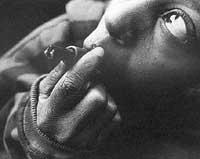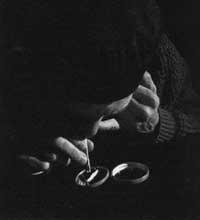Immunology in the fight against cocaine
1997/09/01 Ayerbe Diaz, Mirari Iturria: Elhuyar aldizkaria
In recent years, the use of cocaine and other psychostimulants has experienced a spectacular boom. In the United States, for example, if at least once 5.4 million people were recognized in 1974, in 1985 the figure reached 25 million. A study carried out in our Autonomous Community in 1992 placed the consumer around 0.9%.
In fact, the consumption of cocaine has suffered major falls throughout history. A. A. C. C. Inca VI. In the eighteenth century they already chewed the coca leaf in their celebrations, but in a very small way. The expansion of consumption occurred after the conquest of Peru by the Spaniards with foreman among the oppressed Indians. In Europe, however, the XIX. It was not extended until the mid-twentieth century. After an Italian neurologist praised the benefits of coca, the researchers studied it, isolating the cocaine itself and discovering its chemical formula. Surgery also begins to be used as an anesthetic witness. On the other hand, it became an ingredient of stimulating drinks like “vin Mariani” and the first “Coca-Cola”. Freud himself recommended the use of cocaine as a drug in the work “Über Coca”. Thanks to this, it became one of the most consumed drugs in Europe.
However, the first case of dependence would soon appear, which caused distrust among physicians. This did not affect other uses. In the years 1930-40 Germany was the world's largest consumer, but the II. The massive use of amphetamines during the World War caused the decline in cocaine consumption. In the 70's it rose again and so on until today.
The form of consumption has also changed. At first the coca leaves were chewed, then the coca drinks were filetched, but today most prefer to snoop. This form, having a lower capacity to generate dependency, was popularized the feeling that the cocaine does not damage, which facilitated the increase in consumption.
When Crack appeared, with lower prices, people began to consume this substance. Crack is obtained after treating cocaine with water. This substance more easily crosses the limit between blood and brain, which favors dependence and facilitates intoxication. In view of the destructive effects of crack, scientists were forced to rethink what was thought about cocaine, and they immediately discovered that the belief of safety is false. Cocaine influences the reticular structure of the brain stem, specifically in the system of neurotransmission of monoamines, due to its ability to generate dependence.
These neurotransmitters are noradrenaline, dopamine and serotonin, but cocaine only acts on systems that use dopamine. Therefore, in the fight against cocaine, it has been very important to analyze how dopaminergic neurotransmission works and at what point the cocaine incites. After knowing all this, psychotherapy has begun to use some drugs, especially to deal with the symptoms that occur when they stop taking cocaine and reduce their hobby, but unfortunately they have not yet found a miracle drug.
Immunology offers us new paths in this fight. This section of science has analyzed the interactions between antigens and antibodies, and it can be said that it has achieved the ability to create an adequate antibody in each case. These antibodies currently have a wide use, not only as indicated by classical immunology, to know and relate the antigens, but, from there, they can be used as catalysts, reducing the activation energy necessary for the chemical process to occur.
The antibodies, therefore, can be designed for each case, for which only the model known as hapteno is necessary. Hapteno is a molecule similar to the chemical structure that will bind the antibodies. Once the molecule is synthesized, the rat is injected to form specific antibodies and then analysed if the antibodies have the expected activity level.
Twenty-four years have already begun to design antibodies with cocaine and anti-drug activity. In 1972 they discovered that antibodies, specific to certain drugs, could weaken their effects. In 1974, the heroin vaccine was tried, with unsatisfactory results. Three years ago a group of antibodies was prepared capable of degrading cocaine, but the degradation did not occur as quickly as expected.
The main finding that immunology has provided us has been the vaccine against the excessive use of cocaine, the Haptene synthesized by a group of researchers from the Scripps Research Institute in La Jolla, California (see figure 1).
The molecule has been linked to a protein, the protein KLH, and the antibody obtained after the syringe of the rats has shown a very interesting activity: the cocaine does not enter the blood and the brain (see figure 2). After giving the same amount of cocaine to grafted and unembedded rats, grafted rats have found that they have much less cocaine in the brain than the others, 18% of what unvaccinated rats have.
This has two advantages. On the one hand, it does not allow cocaine to be affected in the brain, reducing the capacity to generate hobby, and on the other, Hapteno himself does not act on the brain, that is, it does not have the possibility of producing unpleasant side effects.
Those who have prepared the vaccine say that those who want to leave cocaine can give them a great help. Some psychiatrists, for their part, consider that it can prevent afition and even treat patients with overdose.
They have not been the only researchers working on the preparation of the cocaine vaccine. A group of ImmunoLogic Pharmaceutical Corporation of Massachusetts has achieved something similar, but they have not made their results public, we must not forget that ImmunoLogic is a private company.
Of course, we are talking about vaccines that are still in the first phase of training, since we do not know if they will be really effective or not. What scripps have prepared has a duration of 20 days in the body of the rat. If this limit is exceeded, it has no effect and, of course, for the vaccine to be effective it must last months or years. Another problem may be if the increased dose will not be enough to eliminate the effect of the vaccine. It seems that the ImmunoLogic vaccine can support higher doses.
In the last year there have been more groups of researchers who have begun the preparation of this type of vaccines by means of the synthesis of new haptenos, both for the union of the cocaine molecule and for the catalyzation of its degradation, but for the moment we have very little news, since the experimental phase has begun.
The problem remains unresolved, but there is no doubt that this discovery has awakened new hopes among those affected by cocaine disease.

Gai honi buruzko eduki gehiago
Elhuyarrek garatutako teknologia






